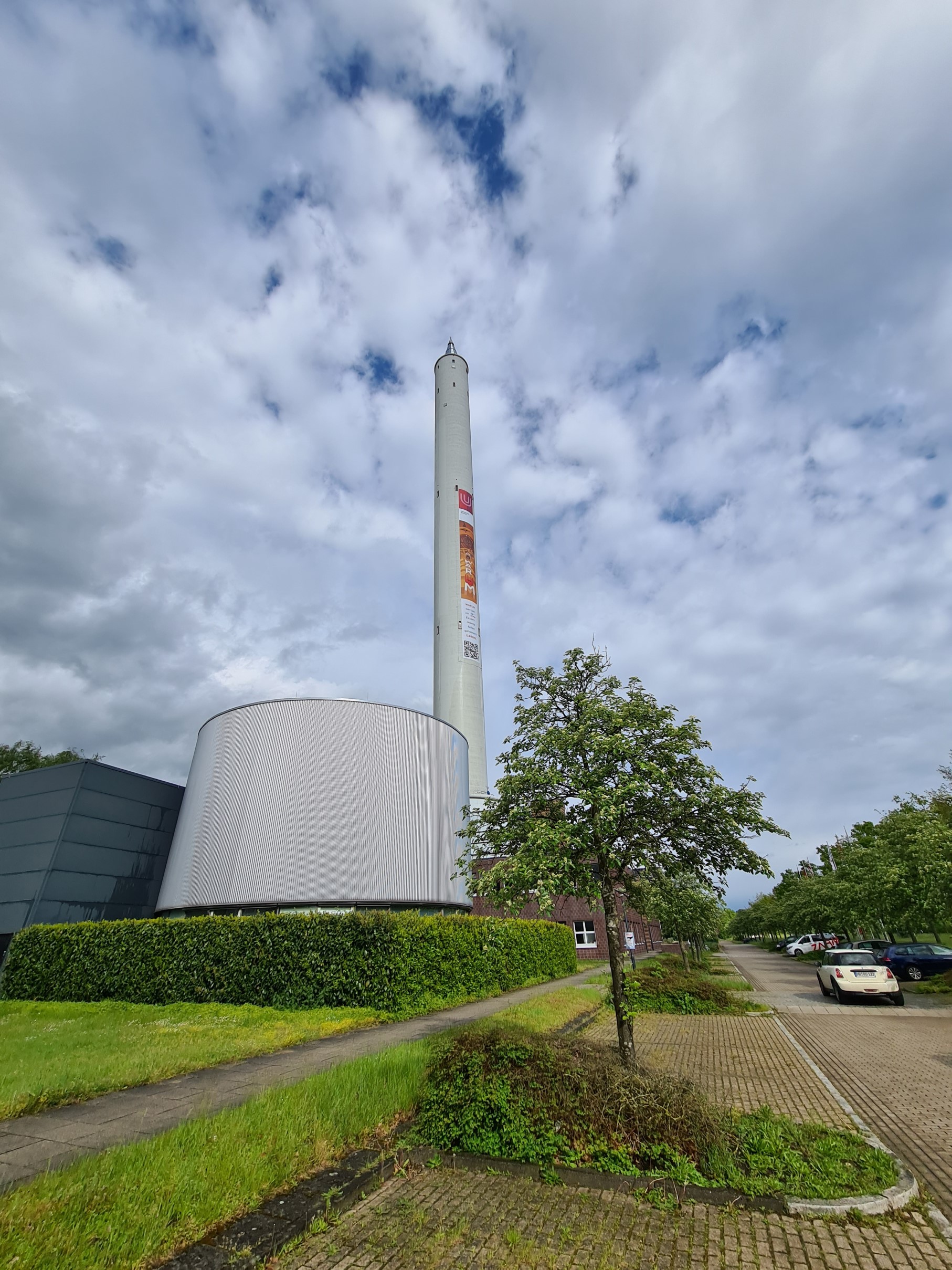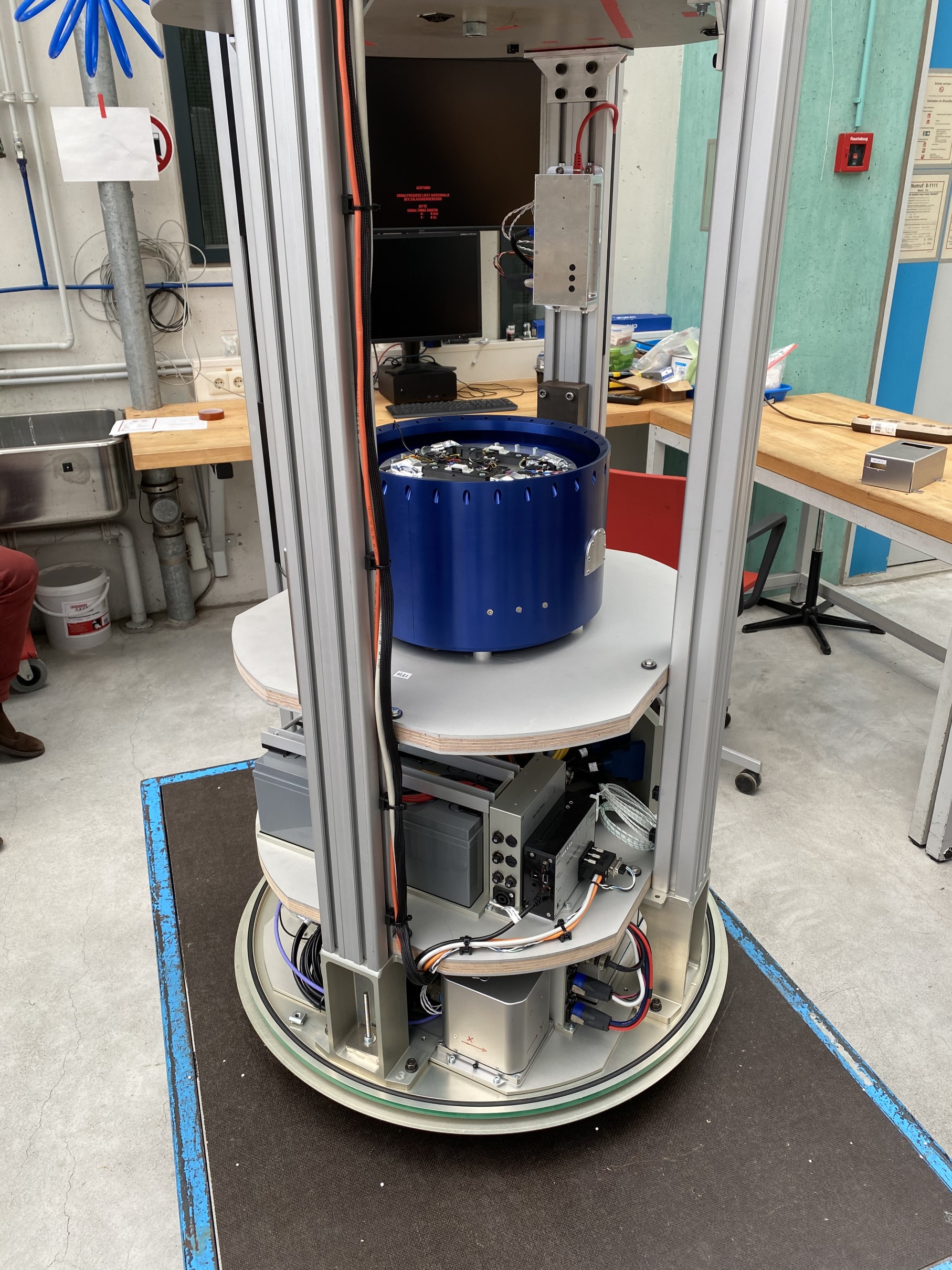S Cephei ZARM Drop Tower Campaign 2021

Corona also left its mark on the S Cephei team. In spring 2020, we were informed that the REXUS campaign would unfortunately have to be postponed by one year. This was sobering news, as the experiment was already well on its way to being operational. But due to the advanced state of development of the experiment, ZARM from Bremen offered us the opportunity to test the experiment in their drop tower before the actual rocket flight and thus already collect first scientific data.
The Center of Applied Space Technology and Microgravity (ZARM) is one of the organizers of the REXUS/BEXUS program. The institute has a 146 m high drop tower in which experiments can be exposed to microgravity for up to 9.8 s. This short time is suitable for our experiment, since the alignment process of CNTs (carbon nanotubes) does not take much longer than a few seconds at certain power parameters. Although we have to limit ourselves to half of the chambers due to the short microgravity and limited electrical power, the high repeatability of up to two flights per day made the drop tower campaign a welcome opportunity to perfectly prepare the experiment for flight in the sounding rocket in Kiruna.
The campaign ran from May 10 to 22, 2021. The experiment was already sent to Bremen the week before the campaign. The team members Robin, David, Jonathan and Joshua then followed the experiment to Bremen on May 9. We were accommodated in apartments of the 7THINGS-Hotel, which is centrally located on the university campus and only 5 minutes away from ZARM.

The first week was scheduled for testing and integration of the experiment.
The PoC (Pillars of Creation) system, the electronics standard developed by STAR, had already been tested for functionality prior to the campaign, but had never actually been used. Patience had to be maintained here, as commissioning was delayed due to sometimes unknown problems. Due to PoC's modular principle, troubleshooting required a certain degree of precision, but at the same time, any errors found could be fixed in a very short time by replacing the damaged module. When the hardware and software were finally ready for use, nothing stood in the way of installing the PoC stack.
The experiment was controlled via the ZARM ground station, which is in direct contact with the capsule inside the drop tower.
In addition to working on the project, there was of course time to visit the city of Bremen. In addition to impressive architecture, Bremen's old town also has some natural retreats to offer, such as the meadows and green spaces along the Weser River. The campus of the University of Bremen also offered the opportunity to relax with a visit to the nearby campus lake.
The second week in Bremen was the flight week. We started on Monday with the calibration of our drop tower capsule, in which the S Cephei experiment was installed. The center of gravity of the capsule was determined with a special measuring device and brought to the desired position by attaching mass pieces. If the center of gravity of the capsule was not exactly in the middle of the capsule, rotation would occur during the fall, which could have fatal consequences.
For a drop tower flight, our experiment was first installed in the drop tower capsule, which also contained an additional on-board computer for power and communications. This capsule was sealed airtight by an outer shell and then moved to the inside of the drop tower. Inside the tower is a very large vacuum chamber, which consists of a room on the first floor and the actual drop tube. The lower room contains the launch and recovery equipment. Our capsule was lifted onto the catapult at the bottom of the drop tower and then the vacuum chamber was evacuated. Since this process takes about 90 minutes, there was enough time to establish communications with our experiment from the control center. Once the chamber was pumped empty of air, the hydraulically operated catapult could be preloaded. After that, it was up to us to launch via the ground station. The catapult accelerates the capsule with up to 35g, while the on-board computer of the capsule simulates the signals of the REXUS rocket and can thus control our experiment. After about 9 to 10 seconds, the capsule gently lands again in the recovery container. This container, filled with damping Styrofoam beads, can swing over the launcher after the catapult shot and thus catch the capsule again. As soon as the chamber pressure was equalized again, the capsule was lifted out of the catching container by a crane and we could immediately evaluate all data. However, due to a live video transmission from a camera, it was already possible to observe the alignment process of the CNTs during the flight.

We had already extensively tested various parameter combinations in our experiment setup in Dresden as a reference and were thus able to set up a precise plan with the experiments to be performed at ZARM. The first launch was actually scheduled for Monday afternoon. Due to difficulties with the capsule's on-board computer, we eventually had to postpone the first flight until Tuesday. During this particularly exciting first flight, our experiment worked smoothly. On the second flight of the day, however, unexpected complications arose. Already during the evacuation procedure, it turned out that the communication via WLAN was heavily lossy. Even a restart of the communication systems could not solve this problem. But it got even worse when, during our routine test run, an erroneous command corrupted the program. Recompiling the program and copying it to the on-board computer failed because of the weak connection to the capsule. This was due in part to the fact that the catapult was already in the cocking process and thus the capsule had disappeared into the tube of the catapult, which did not improve the quality of the connection. The catapult may remain tensioned for a maximum of two minutes, because otherwise the hydraulic oil would become too hot. All attempts to get the experiment ready to fly failed during this time, so we had to start the flight without a running experiment.
This failure made us realize that we should not take the time before the launch lightly either. From then on, before the upcoming flights, the software was copied to the on-board computer with Ethernet cables and the test run was done with the catapult untensioned and only with a good connection.
With this lesson learned, we were then able to perform two more flights each on Wednesday, Thursday and Friday. Particularly exciting and impressive for us were also the acquired insights into the technology that makes the drop tower operation possible. Among other things, we were shown and explained the catapult equipment located several meters below ground. In addition, we were able to take the elevator up to the top of the drop tower, from where we had a great view over the flat Bremen countryside.

In total, we were able to perform seven successful flights, each with two different experiment configurations. This result has definitely exceeded our expectations and is thus a complete success! All recorded videos of the experiments have to be evaluated now, and we are currently testing different software solutions for tracking the individual CNT particles during the alignment process. The capsule's on-board computer also recorded some flight and performance parameters during the flights, which means we now have even more data to optimize our systems for the Kiruna flight.
During the campaign, however, we not only gained scientific knowledge, but also gained many skills in terms of conducting such a campaign. The biggest insight for us is that you can never do too much testing in advance.
The departure went as planned and on Friday evening the IC in the direction of Leipzig departed punctually from the main station in Bremen. On the train we could use the several hours of travel time to reflect on the eventful stay in Bremen.
However, there will still be some work to do before the campaign in Kiruna. For example, the electronics still have to be tested for their thermal behavior in a vacuum, the ground station has to run without errors, and the lighting of the chambers has to be reworked. In addition, there will be small quality-of-life improvements on the mechanics side and then nothing should stand in the way of a successful start in Kiruna.
Finally, we would like to thank ZARM again for their support both with REXUS and with this campaign. Without you all this would not have been possible! The drop tower campaign was very valuable for us and our experiment. We would also like to thank all of the staff for their support during any complications. We are very excited to be back at ZARM during the upcoming Benchtest week and to see all the people again.

Leave a Reply